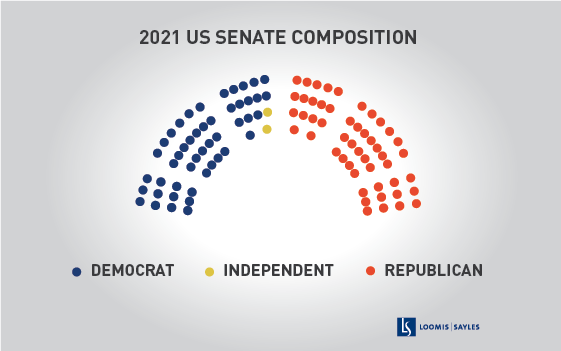For months now, US political watchers have been focused on the first week of January 2021. It was clear this week would be politically significant, with the new Congress convening January 3, Georgia’s January 5 runoff elections set to determine party control of the Senate, and Congressional confirmation of the Electoral College vote on January 6. But the shocking events in our Capitol on January 6 were more than the nation and the world could have anticipated.
Ultimately, our democratic institutions prevailed over chaos, and two months after the November elections, the political environment is finally coming into focus. Joe Biden’s presidential win was officially confirmed, and two Democrat victories in Georgia create a 50-50 split in the Senate. With Vice President Harris as the tiebreaker, Democrats gain control of the legislative branch.
Here are our thoughts on what the 50-50 split in the Senate might mean for the Biden administration’s agenda.

How a 50-50 split can work
A 50-50 split has happened before, but it is not common. The last time the Senate was evenly split between the two parties was in 2001. Republican leader Trent Lott of Mississippi and Democratic leader Tom Daschle of South Dakota cut a power-sharing deal that divided the committees and their resources evenly. Because Republican Vice President Dick Cheney could still break a tie, Republicans had control. Even so, the even split gave the opposition party significant power, but Republicans were still able to pass a $1.3 trillion tax cut, the No Child Left Behind Act, and a big boost to the defense budget.
We could see similar developments this time, but it would require a push to the center.
A shift to the center
The Democratic platform came from an agreement between Senator Bernie Sanders and Joe Biden. It was the price for Sanders conceding the field to Biden. The platform was huge, complex, and expensive.
A 50-50 split in the Senate and a miniscule Democratic majority in the House would not likely allow a progressive platform to pass. To get things done, Biden will need to get at least some Republican support, and he needs to appeal to the more centrist Democrats, in our view.
Proposals like these seem unlikely:
- “Packing" the Supreme Court by adding extra justices, which Democrats could appoint.
- Granting statehood for Washington, D.C. and Puerto Rico to add four additional Democratic senators.
- Abolishing the “filibuster” in the Senate concerning legislation.
- Abolishing the Electoral College and going to direct election of the president.
Confirmations
With Democratic control, President-elect Biden can relax a bit when it comes to nominations for cabinet posts, courts, and regulatory agencies.
As long as Biden is sure he can get 51 votes in the Senate to confirm his nominations (with Vice President Harris breaking ties), Biden will face no major obstacles even if every Republican opposes him.
Some of the nominations to run the regulatory agencies may be more progressive than a Republican Senate would have allowed. That is important because a lot of the action in upcoming years is expected to come from regulatory rulings, not Congressional legislation.
Conclusion
This post only scratches the surface of the ramifications implicit in the new Congressional composition. Budget resolutions, the debt ceiling and the Congressional Review Act are just a few areas where the new Senate majority will be felt.
What are the odds of a follow-up post on taxes and spending? Better than 50-50. Stay tuned.

MALR026590





